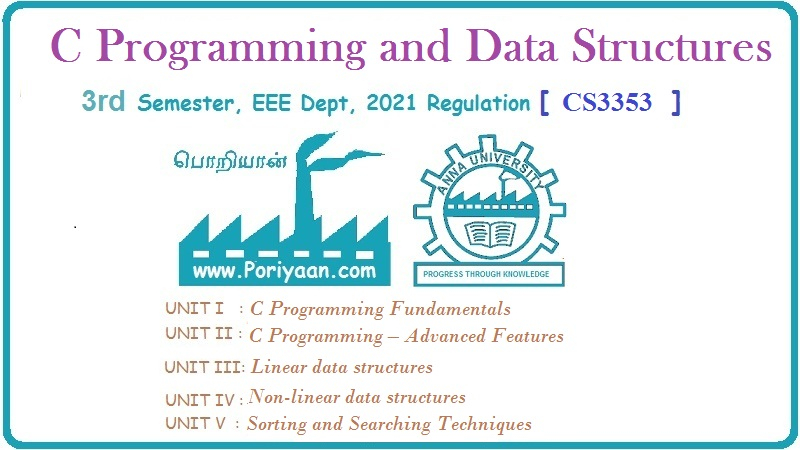C Programming and Data Structures: Unit IV: a. Non-Linear Data Structures - Trees
Two Marks Questions with Answers
C Programming and Data Structures | Non-Linear Data Structures - Trees
C Programming and Data Structures: Unit IV: a. Non-Linear Data Structures - Trees : Two Marks Questions with Answers
Two Marks Questions with Answers
Q.1
What is the difference between linear and non-linear data structures?
Ans.
:
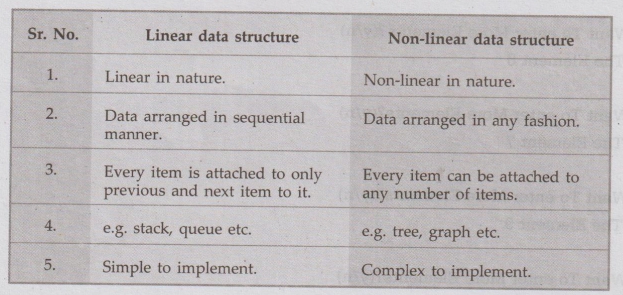
Q.2
Define: Binary tree.
Ans.
:
A
binary tree is a finite set of nodes which is either empty or consists of root
and two disjoint binary trees called the left subtree and right subtree. Refer
Fig.
Q.3
Give various implementation of tree.
Ans.
: The
tree can be implemented by two ways
1.
Sequential implementation: The tree is implemented using arrays in this type of
implementation.
2.
Linked implementation : The tree is implemented or represented using linked
list.
Q.4
Which tree representation is mostly preferred by the developers linked?
Justify.
Ans.
:
There
are two ways of representing the binary tree - sequential representation and
linked representation. The linked representation is normally preferred by
developers because in the linked representation the binary tree is represented
using linked list. Hence the tree with any number of nodes can be created.
Secondly there is no wastage or shortage of the memory in this representation.
Q.5
List the applications of trees.
Ans.
:
1.
In computer networking such as Local Area Network (LAN), Wide Area Networking
(WAN), internetworking.
2.
In telephone cabling graph theory is effectively used.
3.
In job scheduling algorithms the graphs are used.
Q.6
In tree construction which is the suitable efficient data structure ?
Ans.
:
The
linked list is the efficient data structure for constructing the trees. Because
using linked list there is no wastage of memory or shortage of memory. The
nodes can be allocated or de-allocated as per the requirements.
Q.7
What is meant by equivalent binary tree?
Ans.
:
The
two binary trees are said to be equivalent if the sequence of their traversal is
same.
Q.8
Define complete binary tree.
Ans.
:
A
complete binary tree is a tree in which every node except the root node should
have exactly two children not necessarily on the same level. Refer Fig. 5.7.1

Q.9
What is level of a tree?
AU:
Dec.-19
Ans.
:
The
root node is always considered at level zero. The adjacent nodes to root are
supposed to be at level 1 and so on.
Q.10
What are internal and external nodes in a tree ?
Ans.
:
Leaf
node means a node having no child node. As leaf nodes are not having further
links, we call leaf nodes external nodes and non-leaf nodes are called internal
nodes.
Q.11
What is sibling node in a tree?
Ans.
: The nodes with
common parent are called siblings or brothers.
Q.12
What is forest ?
Ans.
Forest is a collection of disjoint trees. From a given tree if we remove its
root then we get a forest. Refer Fig. 5.7.2.
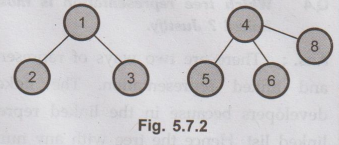
Q.13
What is full binary tree?
Ans.
: A full binary
tree is a tree in which every node has zero or two children. Refer Fig. 5.7.3.

Q.14
List out the traversal techniques used in tree.
Ans.
:
1.
Preorder 2. Postorder 3. Inorder traversal
Q.15
Which traversal results in elements in sorted order?
Ans.
: The
inorder traversal results in elements in sorted order.
Q.
16 How is binary tree represented using an array ? Give an example.
AU:
Dec.-05
Ans.
:
In an array root node will be at position 1. Its left child will be at position
2 and right child will be at position 3. Hence the nodes of tree are placed in
array using following formula -
Parent
(n) = floor ((n-1)/2)
left
(n) = (2n+1)
right
(n) = (2n + 2)
Consider
tree as given below.

It
will be placed in an array as given below.

Q.17
Construct an expression tree for the expression A+ (BC) * D* (E + F).
AU:
May-06
Ans.
:

Q.18
Define binary search tree.
AU:
May-07, ECE, May-08, Dec.-09, 19
Ans.:
Binary
search tree is a binary tree in which each node is systematically arranged i.e.
the left child has less value than its parent node and right child has greater
value than its parent node. The searching of any node in such a tree becomes
efficient in this type of tree.
For
example -
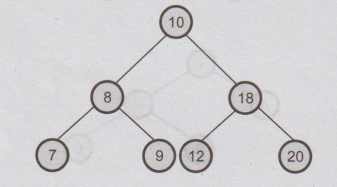
Q.19
List the operations defined on binary trees data type with a suitable example.
Ans.
:
Various
operations that can be performed on binary trees are - 1. Insertion 2. Deletion
3. Traversal
The
insertion operation is performed to insert a node at any desired position.
For
example -
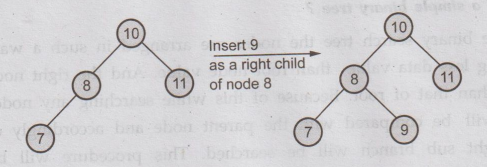
We
can delete any desired node from the binary tree except root node.
For
example -

Traversal
means a walkover a binary tree. It can be preorder, postorder and inorder
traversal.
Q.20
Write an algorithm to declare nodes of a tree structure.
Ans.
Algorithm :
1.
Declare a C structure for the node of a binary tree
typedef
struct node
{
int
data;
struct
node *left;
struct
node *right;
}bin;
2.
Create a node by allocating memory by using the dynamic memory allocation.
New
(bin*)malloc(sizeof(bin));
3.
Initialize the Left and Right child pointers to NULL.
New->left=NULL;
New->right=NULL;
Thus
a single node gets created. This is the first node of the tree, hence it is
called as the root node.
root=New;
4.
Attach the next subsequent nodes to either as a left child or a right child to
the corresponding parent nodes depending on the user's choice.
Q.21
Why it is said that the searching a node in a binary search tree is efficient
than that of a simple binary tree?
Ans.
:
In the binary search tree the nodes are arranged in such a way that the left
node is having less data value than root node value. And the right nodes are
having larger value than that of root. Because of this while searching any node
the value of target node will be compared with the parent node and accordingly
either left sub branch or right sub branch will be searched. This procedure
will be repeated if required. So one has to compare only particular branches.
Thus searching becomes efficient.
Q.22
If a binary tree with n nodes is represented sequentially, then for any node
with index i (a) 1 ≤ i ≤n, then left child (i) is at 2i, if 2i ≤n. (b) If
2i>n, then I has no left child. Name the type of binary tree which satisfies
both (a) and (b).
AU:
May-11
Ans.
:
The complete binary tree.
Q.23
What is meant by equivalent binary tree?
AU
: May-11
Ans.
:
The two binary trees are said to be equivalent if the sequence of there
traversal is same for example -

The
sequence is 8, 8, 9, 10, 11, 12, 13.
Q.24
List the applications of trees. AU: Dec.-11
Ans.
Binary
tree is used in various applications such as -
1.
Binary search tree
2.
Game tree
3.
Expression tree
4.
Threaded Binary tree.
Q.25
Define binary tree and give binary tree node structure.
AU:
Dec.-12
Ans.
: A binary tree is a finite set of nodes which is either empty or consists of
root or two disjoint binary trees called the left subtree and right subtree.
Each
node in the binary tree contains three fields left child pointer, data field
and right child pointer.
Left
child Data Right child
struct
BST
{
BST
*leftchild;
int
data;
BST
*rightchild;
};
Q.
26 How many trees are possible with 3 nodes ?
Ans.
:
For
3 nodes there are 23 - 3 trees possible. That means 5 such trees can
be drawn. For example - If there are 3 nodes with the value 10, 20, 30 then
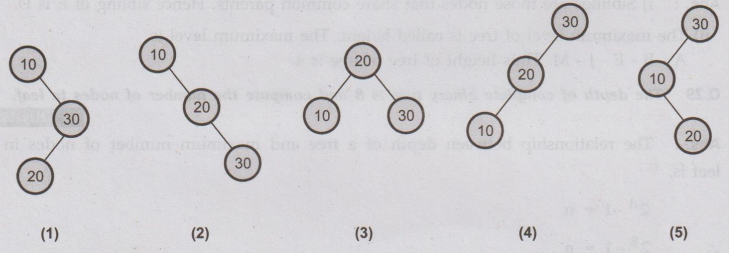
Q.
27 Show the result of inorder traversal of the binary search tree given in Fig.
5.7.4.
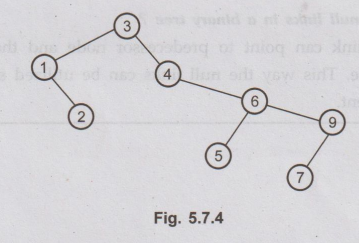
Ans.
: Inorder
Traversal: 1, 2, 3, 4, 5, 6, 7, 9
Q.28
For the tree in Fig. 5.7.5. AU: Dec.-18
a)
List the siblings for node E.
b)
Compute the height.
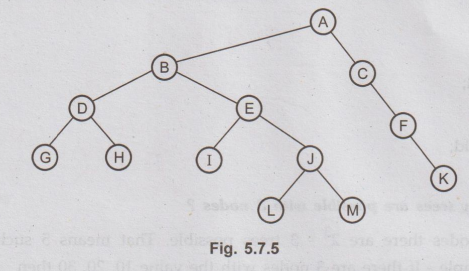 Ans.
: i) Siblings are those nodes
that share common parents. Hence sibling of E is D.
Ans.
: i) Siblings are those nodes
that share common parents. Hence sibling of E is D.
ii)
The maximum level of tree is called height. The maximum level is AB-E-J-M. Thus
height of tree of tree is 4.
Q.
29 The depth of complete binary tree is 8 and compute the number of nodes in
leaf.
AU: May-19
Ans
:
The relationship between depth of a tree and maximum number of nodes in leaf
is,
2d
-1 = n
28
-1 = n
n
= 255
Q.
30 How to resolve null links in a binary tree?
AU:
May-19
Ans.
:
The left null link can point to predecessor node and the right null link can
point to successor node. This way the null links can be utilized so that
tranversing of the tree becomes efficient.
C Programming and Data Structures: Unit IV: a. Non-Linear Data Structures - Trees : Tag: : C Programming and Data Structures | Non-Linear Data Structures - Trees - Two Marks Questions with Answers
Related Topics
Related Subjects
C Programming and Data Structures
CS3353 3rd Semester EEE, ECE Dept | 2021 Regulation | 3rd Semester EEE Dept 2021 Regulation
